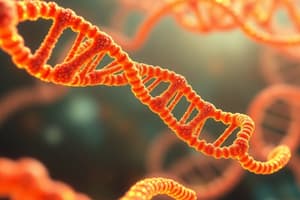Podcast
Questions and Answers
What is the primary structure of a protein composed of?
What is the primary structure of a protein composed of?
- Quaternary structures
- Tertiary structures
- Amino acid sequences (correct)
- Alpha helices and beta sheets
Which level of protein structure is characterized by noncovalent interactions like hydrogen bonding and electrostatic forces?
Which level of protein structure is characterized by noncovalent interactions like hydrogen bonding and electrostatic forces?
- Primary structure
- Secondary structure
- Quaternary structure
- Tertiary structure (correct)
What is the function of proteins in immune responses primarily related to?
What is the function of proteins in immune responses primarily related to?
- Serving structural purposes
- Regulating gene expression
- Participating in gene expression (correct)
- Catalyzing chemical reactions
During protein synthesis, what is the role of amino acids?
During protein synthesis, what is the role of amino acids?
Which level of protein structure involves the formation of subunits to create multimeric structures?
Which level of protein structure involves the formation of subunits to create multimeric structures?
What is the fundamental structure shared by all amino acids?
What is the fundamental structure shared by all amino acids?
During protein synthesis, which molecules are responsible for delivering individual amino acids to the ribosome?
During protein synthesis, which molecules are responsible for delivering individual amino acids to the ribosome?
What cellular component is responsible for protein synthesis through translation?
What cellular component is responsible for protein synthesis through translation?
Which phase of translation involves the addition of each new amino acid to the growing polypeptide chain?
Which phase of translation involves the addition of each new amino acid to the growing polypeptide chain?
How do posttranslational modifications contribute to protein structure?
How do posttranslational modifications contribute to protein structure?
Flashcards are hidden until you start studying
Study Notes
Proteins: Building Blocks of Life
Proteins are complex molecules made up of smaller units called amino acids. These building blocks link together through peptide bonds, forming chains with specific structures and functions crucial to life's processes. Understanding proteins' structure, function, composition, and synthesis provides insights into their essential roles within living organisms.
Structure
A protein's structure is hierarchical, encompassing primary, secondary, tertiary, and quaternary levels. Amino acid sequences form the primary structure, which folds into regular patterns known as alpha helices and beta sheets, constituting the secondary structure. This folding continues until the three-dimensional tertiary structure forms, where noncovalent interactions like hydrogen bonding, electrostatic forces, van der Waals forces, and disulfide bridges stabilize the protein. Beyond this level, subunits can associate to create multimeric structures, referred to as the quaternary structure.
Function
The diverse range of protein structures affords them multiple functions, such as catalyzing chemical reactions, moving other molecules around cells via transport or motility mechanisms, serving structural purposes, participating in immune responses, and regulating gene expression. Each protein has its unique function based on factors including amino acid composition, sequence, and overall shape.
Amino Acids
There are 20 common amino acids found in nature, often shortened to just 20 because some occur in different modified forms. Regardless of variations, all amino acids share a similar fundamental structure composed of a central carbon atom bound to four groups: an amine group (-NH2), a carboxyl group (-COOH), a side chain (-R) with varying properties, and a hydrogen atom attached to the central carbon atom. This diversity in side chains allows different amino acids to take part in various interactions and contribute to hundreds of thousands of possible protein sequences.
Protein Synthesis
Cellular machinery constructs proteins using a process termed translation, occurring in ribosomes localized within cell compartments like the cytosol, endoplasmic reticulum, and chloroplasts. Ribosomes translate messenger RNA (mRNA) templates encoding proteins' amino acid sequences, with transfer RNA (tRNA) molecules delivering individual amino acids and ensuring proper incorporation during polypeptide elongation. Translation begins with initiation, followed by the addition of each new amino acid during the elongation phase before concluding with release factors triggering termination. After translation, posttranslational modifications may further modify the final protein structure, allowing it to fulfill its designated role in the cell.
In summary, understanding proteins involves appreciating their molecular makeup—the interconnectedness between amino acids, protein structures, and functional capabilities. Through exploring these facets, scientists continue to discover and expand our knowledge regarding the fundamental complexities inherent in proteins and their far-reaching influence across biology.
Studying That Suits You
Use AI to generate personalized quizzes and flashcards to suit your learning preferences.





